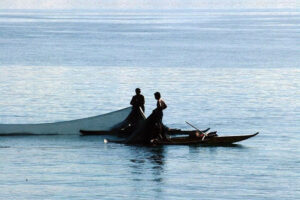AN OCEAN conservation group said the 5% decline in fisheries output could lead to a food security crisis.
Oceana said the “disturbing” decline means production levels have fallen to the “lowest in two decades.”
It was citing output data issued by the Philippine Statistics Authority.
It said marine municipal fisheries production dropped 8.8% to 802.77 thousand metric tons (MT) in 2024 — the lowest since 2002.
“This further reduces the share of small-scale fishers in total fisheries production to only 19.8%,” Oceana said in a statement, flagging the potential consequences of a Supreme Court decision allowing commercial fishing in municipal waters.
Oceana said commercial fisheries production, which accounted for 21.2% of total production, rose 4.2% to 857.33 thousand MT in 2024.
“This downturn in fishery output will continue and will jeopardize the livelihoods of millions who depend on marine resources if illegal commercial fishing is legitimized within the 15-kilometer municipal waters zone,” Oceana Vice-President Gloria Estenzo Ramos said.
“Commercial fishing inside municipal waters and overfishing have long plagued Philippine waters, depleting fish stocks and degrading marine ecosystems. These practices threaten biodiversity and can trigger the collapse of essential fish populations,” she added.
The Supreme Court upheld a decision by a Malabon City court that invalidated the definition of municipal waters in the Fisheries Code, allowing commercial scale operators to fish in these waters.
In response, Cagayan de Oro City Rep. Rufus B. Rodriguez has filed a bill to make the municipal waters exclusive for the use of small-scale fisherfolk.
Kabataan Party-list, GABRIELA Women’s Party-list and ACT Teachers Party-list, meanwhile, filed a House resolution directing the Committee on Aquaculture and Fisheries Resources to investigate the impact of the high court’s decision.
The 1987 Constitution and the Local Government Code and the Fisheries Code recognize the need to grant preferential access for artisanal and municipal fisherfolk to municipal waters.
Citing data from the General Bathymetric Chart of the Oceans, Oceana said the court’s ruling will open up more than 90% of the municipal waters for 533 out of 884 coastal municipalities to commercial fishing vessels.
“Legitimizing illegal commercial fishing in the reserved 15-kilometer zone for artisanal fisherfolk poses grave consequences for artisanal fishers, who will unfairly compete with technologically advanced and more efficient commercial fishing vessels,” it said.
“The daily catch of municipal fisherfolk, which sustains their families and local markets, is at risk of significant reduction, pushing many into economic hardship and hunger,” it added. — Kyle Aristophere T. Atienza
